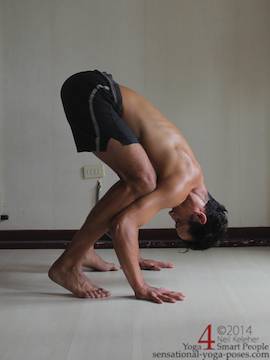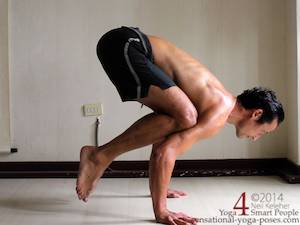Fear of going wide around corners while cycling
While I was in the army a friend and I would go cycling after work. On our regular route was a short but steep downhill followed by a sharp turn to the left. The running challenge was to do the whole thing without braking. This was in England and so we rode on the left side of the rode. When ever I tried doing it full tilt I always ended up swinging out into oncoming traffic. I was afraid of going wide and invariably, when I didn't use the brakes first that is where I went.
I narrowly avoided a car coming the other way.
Fear of falling in corners while speedskating
I also experienced this fear while doing short track speed skating.
Up to a certain speed I was find but then when I passed a particular threshold, the corners became too fast and my fear, as when cycling, was that I'd fly out of the corner and go crashing into the mats.
I used to have the same fear while motorcycling.
Learning how to fall (or fail) safely
I don't think I was ever afraid of falling when I first learned headstand.
When I learned how to do headstand I was detemined to do it by lifting up with legs straight and in the middle of the room. It took me three months of constant practice and constant falling. But I didn't worry too much about it because falling wasn't a big deal. I rounded my back and rolled. It was actually a little bit thrilling to start getting a taste of balance… yes, got it, got it, then I'd feel myself rolling out. Haven't got it.
Perhaps one of the most useful bits of information I got from all of the Robert Kiyosaki/Rich Dad Poor Dad books was the idea of failing safely. I can't remember which book it was but he talks about visiting the field where the Wright brothers took their first flight. I know I've seen lots of videos of experimenters trying to fly and in most of them they jump of something relatively high. Kiyosaki notes in his book that the Wright brothers didn't have a particularly high jump off. He said something along the lines that "they could fail safely".
And that's what I suggest to students who are learning headstand. While initially I'll have students practice headstand against a wall, just to get used to being upside down, eventually I'll have them moving away from the wall. And as part of getting them comfortable with this idea, one of the first exercsies I have them do prior to trying it is learning how to roll, with a rounded back and relaxed fingers. Once they can do that they can go about trying headstand and failing safely till they can actually do it.
Dealing with fear gradually
When I was still living in Calgary a friend took me out snowboarding. When I first saw the mountain that we would be going on I thought "holy shit". It was steep. Very steep.
I picked up a snowboard from rentals and hit the kiddy slope. And I didn't even go to the top. I started close to the bottom. And I worked at learning to control the board and my body. Because there was only a short distance to go I didn't have to worry about my lack of control. I wasn't going to get up enough speed for it to be a problem. And because the run was pretty short, very short, I could really focus on what i was doing. I eventually learned that if I leaned backwards then I couldn't steer the board. But If I leaned forwards, just enough, I could shift weight to either edge and then I could steer. With this understanding in place I gradually worked my way up to more challenging slopes and instead of being scared I was enjoying myself.
Leaning into the thing that scares us
At the time it seemed quite profound that in order to stop being scared I had to do the thing that scared me most, and that was leaning forwards. But ironically, by leaning forwards I gained control instead of losing it, and then I wasn't scared anymore. Instead I could have fun.
Sometimes fear is a result of where you look.
Choosing a different thing to focus on to dispel fear
An ex-girlfriend told me that when she rides a roller coaster or other scary ride she doesn't look at the bottom of the drop. She looks ahead, at whatever is beyond the drop. I tried it myself and found that it wasn't quite as scary. But then I kind of enjoyed the scare and so I looked down.
Fear can result from the way you think
Doing bakasana or some other arm balance, I found on occasion that I was scared even while looking forwards.
The thought that was running through my mind was "I don't want to go there". I was worried about crashing my face into the floor. As a result I couldn't get my feet off of the ground, or if I could then I couldn't keep them up.
I changed the way I thought. Insteaad of being afraid of crashing forwards I made my intent as if I was reaching forwards, like I was trying to kiss the floor. But I resisted the tendency by pressing my fingers into the floor, just enough to stay balanced.
As a side note one of my most popular videos on youtube is for bakasana. I think it is so popular because I break the pose down into very small elements that are easy to practice. And that's kind of like starting at the bottom of a nursefy slope. It allows students to gradually get used to the pose. It also gives them clear exercises to focus on. As a result fear is less likely to come up.
Getting over a fear of cornering while motorcycling
Riding the Laguna Sega race track while on a motorcycle riding course, I came off my bike in a corner called the cork screw. I later figured out that it was because I'd been looking down. I'd been looking down, thinking about something else while going around a corner. The rest of my body followed and so I ended up on the tarmac sliding with my bike in front of me.
The next day I got back on, and every corner I went around I was scared. I felt like I was going to slide out again. I then realized it was becasue I was looking towards the outside of the corners. And that's where I went. So I started looking ahead of myself, into the turn and where I wanted to go instead of out of it. My fear went away and riding became fun again.
What was interesting is that I didn't even have to focus on any particular technique. I simply looked at where I wanted to go and the bike went there.
Minimizing fear of surprises by getting a better view of what's ahead
At the end of that course, one of the instructors pulled me aside to give me a video apraisal. He had a lot of riders to work through. His one suggestion that was perhaps worth the price of admission was that I wasn't using the track. Coming out of a turn I wouldn't move early enough to prepare for the next corner.
As I experimented with this advice on the road, I realized that positioning myself was actually a way to improve my view of the way ahead. And this was a way to overcome another sort of fear.
Riding around a blind right corner, if I stayed close to the right side of my lane I found myself going really slowly because I couldn't see what was ahead. But if I shifted to the left side of the lane just enough I could see quite a bit further ahead. And that meant that I could respond earlier to whatever lay ahead.
That meant that I could go faster without being afraid because I could easily see what was ahead, which meant that I could respond sooner without any danger to myself or anyone else.
Basic tips for overcoming fear
So what are some basic ingredients for overcoming fear (in particular when learning new skills)?
Make it safe to fail. That can mean using a short stretch of hill if skiing or snowboarding, or using an empty car park is practicing something with a motorbike or bicycle. It can mean practicing rolling out prior to doing freestanding headstands. A big part of failing safely is being aware of what can happen and of looking around you. So for example, a good idea when doing inversions is to make sure that if you do fall out the area around you is free of objects that will hurt you if you fall, and that it is free of people or objects you may hurt if you fall.
Improve sensitivity and control. Control without sensitivity is useless. Sensitivity is how you know when your control inputs are working. But it is also how you know what you have to deal with. And it is also a way of directing where you want to go.
Using a wall for headstand or other inversion is a way of creating control. The wall is something that we can use for stability and to press against or rest against.
To make sensitivity and control easier to learn it helps to focus on little bits at a time. Learning to ride a motorbike we learned one control element at a time. We learned how to use the brakes. Then we learned how to steer. Then we learned how to increase speed. The same can be true with the body. Going back to the example of crow pose, creating exercises for each element of crow pose, I made the whole pose easier to learn. (I'd suggest the success of this technique can be gauged by the comments for that video.)
One of the things that we can learn to consciously control is our muscles.And luckily, muscles are actually something that we can feel activating. They are what allow us to feel our body.
To help overcome fear, know what you are trying to do. Know where you are going. And don't forget the eyes. Directing the eyes is a simple way to know where we want to go. And if you have a difficulty seeing where you are going then adjust your position so that you have a better view of the way ahead.
Published: 2015 06 26
Updated: 2020 10 30




